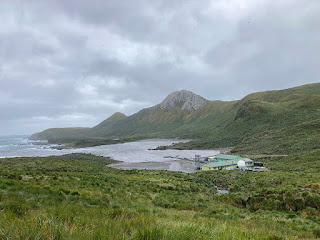I have now been back at Bird Island long enough for it to feel like home, and I am still very pleased to be here. I am one of six zoological field assistants here, and between us we conduct long term monitoring studies of the various wildlife. Out work is largely divided into three topics, with two field assistants working on each. My role is to work on the penguin and petrel monitoring, with the other two topics being the seals and albatrosses. Normally these positions are 18 months long, spanning two breeding seasons with a winter in between, but I am filling a short term gap left by a someone else having to leave early. The work is nice because in addition to having our own responsibilities, there is plenty of opportunity to get involved in everyone else’s too.
The wildlife that comes to Bird Island each season to breed has been intensively studied for nearly 70 years, and a permanent, purpose built research station exists here to facilitate this.
Much of our work is long term monitoring, with the same groups of birds and seals studied each season over many years. Studying a sub-set of the populations is a manageable way of allowing us to see the wider picture of how the various species are doing. We can compare data over many years and monitor the long term trends in the population size and breeding success of each species. As similar data is collected at other research stations around Antarctica, when combined, we can get an overall picture of the health of the Antarctic ecosystems as a whole.
Maintaining the long term data sets involves following each species through the breeding season, with various important counts along the way that tell us how the birds are doing and attempts to explain good/poor breeding season. For the penguins, this starts in spring (November). We weigh adult penguins who have returned to breed (the heavier the birds on arrival, the better condition they are in for breeding). We then monitoring the start of the nesting season (to get first egg laying dates etc (to enable subsequent population counts to be consistent across the years). Later we do nest counts of certain colonies once the birds have all returned and settled. Further through the season we conduct chick counts of the same nests once the eggs have hatched (in a good year where food is plentiful, gentoo penguins can successfully rear two chicks, in a poor food year they manage to raise only one to fledging, or none at all). Fledgling counts of the same colonies are then done to see how many chicks per pair survive (by now we are in January), and finally chick weighing to see how heavy they are (and therefore what condition they are in) when they are ready to fledge at the end of the season. The penguins mostly nest on the beaches by the shore (gentoo penguins)…
or on rocky areas (macaroni penguins).
The giant petrels (and many of the other flying birds studied here) are monitored in a slightly different way to the penguins. For these, we walk their nesting area daily early in the breeding season, and mark each nest with a numbered stake on the day the egg is laid. The giant petrels build individual nests of moss across the meadows.
Each individual nest is then monitored through the breeding season until the chick (hopefully) fledges at the end of the summer. We put uniquely numbered leg rings on these birds and their chicks. This enables us to see how the birds interact with each other, who is breeding with who, and how long they live. Ringing chicks provides valuable data as it means we know exactly how old they are. Most albatrosses and giant petrels return to where they hatched to breed. This is a nesting pair of wandering albatrosses.
Our oldest albatrosses were ringed as chicks in the 1960’s and some of our oldest breeders are now 60 years old- it is a real privilege to be able to see and work with these birds.
In addition to the long term monitoring programme, we study other species, and other aspects of the wildlife’s behaviour, but I’ll write more about that another time.








No comments:
Post a Comment